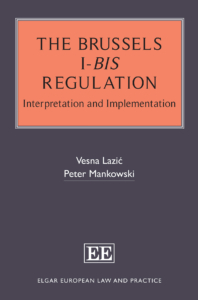Out Now: The Brussels I-bis Regulation (Lazic & Mankowski)
Vesna Lazic and Peter Mankowski, The Brussels I-bis Regulation: Interpretation and Implementation, Edward Elgar 2023 (602 pp)
This impressive book on the Brussels I-bis Regulation has just been published. It results from a project headed by Vesna Lazic (Utrecht University/T.M.C. Asser Institute) and the late Peter Mankowski (formerly University of Hamburg), in co-operation with Lucia Pein (Hamburg University), entitled ‘Regulation Brussels Ia: a standard for free circulation of judgments and mutual trust in the European Union’ (JUDGTRUST) funded by the European Commission’s Justice Programme (JUST-AG-2017/JUST-JCOO-AG-2017). The research for this project consisted among others of a questionnaire and national reports from all the Member States on the application of the Regulation. This book provides an extensive overview of the CJEU rulings and analysis of case law, which will be of great importance for future reference and the ongoing evaluation and revision of the Brussels I-bis Regulation.
Many congratulations to Vesna Lazic for completing the demanding task of finalising the publication without her co-author. Quoted from her Foreword: “This book is dedicated to the memory of his friendship, his outstanding work and his unprecedented contribution to private international law scholarship.”
The blurb on the publisher’s website reads as follows:
The Brussels I-bis Regulation remains the most significant legal instrument for procedural law in the EU, providing the cornerstone for questions of international jurisdiction and enforcement of judgments in civil and commercial matters. This authoritative book provides a thorough and practical analysis of the Regulation, with particular focus on its implementation and application.
With comprehensive coverage of the relevant CJEU case law, and rigorous analysis of the jurisprudence of the Brussels Regulation, this book acts as both a detailed reference work for the understanding and practical application of the Regulation, and a roadmap for its future. It highlights the challenges involved in the application of the Regulation, such as interpretation of its concepts and the achievement of its underlying purposes, as well as the efficiency and potential costs, and provides suggestions for legislative improvements.
Further information and a free download of the first chapter are available at the publishers platform here.



